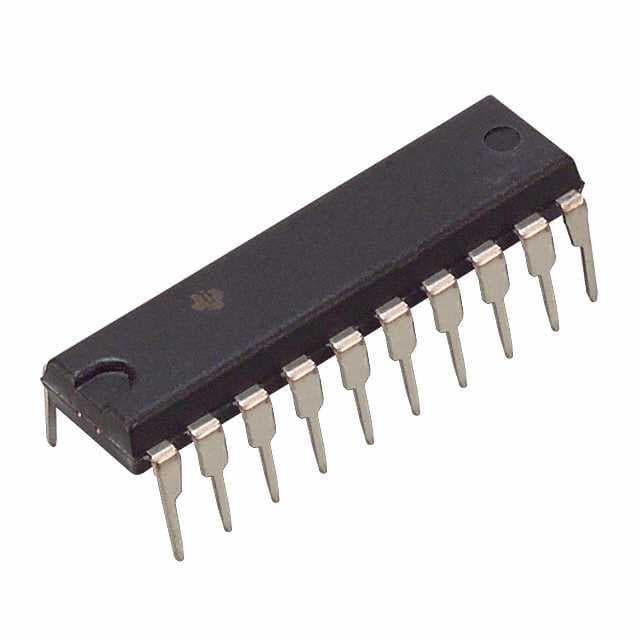Lihat spesifikasi untuk detail produk.

SN74ABT2245N
Product Overview
Category
SN74ABT2245N belongs to the category of integrated circuits (ICs).
Use
It is commonly used as a bidirectional octal bus transceiver.
Characteristics
- High-speed CMOS technology
- 8-bit wide bidirectional bus interface
- Non-inverting outputs
- 3-state outputs for bus-oriented applications
- Output sink capability of 64 mA, source capability of 32 mA
- Power-up 3-state
- Available in various package options
Package
SN74ABT2245N is available in a variety of packages, including DIP (Dual Inline Package) and SOIC (Small Outline Integrated Circuit).
Essence
The essence of SN74ABT2245N lies in its ability to provide bidirectional communication between two buses with different voltage levels.
Packaging/Quantity
SN74ABT2245N is typically packaged in tubes or reels, with quantities varying depending on the manufacturer and distributor.
Specifications
- Supply Voltage: 4.5V to 5.5V
- Input Voltage: 0V to VCC
- Output Voltage: 0V to VCC
- Operating Temperature Range: -40°C to +85°C
- Propagation Delay Time: 6 ns (max)
- Output Current: ±64 mA
Detailed Pin Configuration
- OE (Output Enable) 1
- A1 (Input/Output) 1
- B1 (Input/Output) 1
- GND (Ground)
- B2 (Input/Output) 2
- A2 (Input/Output) 2
- OE (Output Enable) 2
- VCC (Supply Voltage)
- B3 (Input/Output) 3
- A3 (Input/Output) 3
- B4 (Input/Output) 4
- A4 (Input/Output) 4
- OE (Output Enable) 4
- GND (Ground)
- A5 (Input/Output) 5
- B5 (Input/Output) 5
- A6 (Input/Output) 6
- B6 (Input/Output) 6
- OE (Output Enable) 6
- VCC (Supply Voltage)
- B7 (Input/Output) 7
- A7 (Input/Output) 7
- B8 (Input/Output) 8
- A8 (Input/Output) 8
- OE (Output Enable) 8
- GND (Ground)
Functional Features
- Bidirectional data transfer between two buses
- Non-inverting outputs for direct communication
- 3-state outputs for bus-oriented applications
- High-speed operation suitable for time-critical applications
- Power-up 3-state feature ensures bus isolation during power-up and power-down conditions
Advantages
- High-speed CMOS technology allows for efficient data transfer
- Non-inverting outputs simplify communication between different voltage level buses
- 3-state outputs provide flexibility in bus-oriented applications
- Power-up 3-state feature ensures reliable bus isolation during power transitions
Disadvantages
- Limited output current capability compared to some other transceiver ICs
- Requires careful consideration of voltage compatibility between the two buses
Working Principles
SN74ABT2245N operates by receiving input signals from one bus and transmitting them to the other bus bidirectionally. The non-inverting outputs ensure that the transmitted signals maintain their original logic levels. The 3-state outputs allow the device to be effectively disconnected from the bus when not in use, preventing interference and enabling multiple devices to share the same bus.
Detailed Application Field Plans
SN74ABT2245N finds applications in various fields where bidirectional communication between buses with different voltage levels is required. Some common application areas include:
- Industrial automation systems
- Automotive electronics
- Communication equipment
- Computer peripherals
- Consumer electronics
Detailed and Complete Alternative Models
- SN74ABT2244: Octal buffer/line driver with 3-state outputs
- SN74ABT245: Octal bus transceiver with 3-state outputs
- SN74ABT16245: 16-bit bus transceiver with 3-state outputs
- SN74ABT573: Octal transparent latch with 3-state outputs
These alternative models offer similar functionality and can be considered as alternatives to SN74ABT2245N based on specific requirements and design considerations.
Word count: 570 words
Sebutkan 10 pertanyaan dan jawaban umum terkait penerapan SN74ABT2245N dalam solusi teknis
Sure! Here are 10 common questions and answers related to the application of SN74ABT2245N in technical solutions:
Q: What is SN74ABT2245N? A: SN74ABT2245N is a type of octal bus transceiver with 3-state outputs, commonly used for bidirectional data transfer between different voltage levels.
Q: What is the operating voltage range of SN74ABT2245N? A: The operating voltage range of SN74ABT2245N is typically between 4.5V and 5.5V.
Q: How many channels does SN74ABT2245N have? A: SN74ABT2245N has 8 bidirectional channels, allowing for simultaneous data transfer in both directions.
Q: Can SN74ABT2245N handle different voltage levels on its input and output sides? A: Yes, SN74ABT2245N is designed to handle voltage translation between different voltage levels, making it suitable for interfacing between devices with different logic levels.
Q: What is the maximum data rate supported by SN74ABT2245N? A: SN74ABT2245N can support data rates up to 100 MHz, making it suitable for high-speed applications.
Q: Does SN74ABT2245N have built-in protection features? A: Yes, SN74ABT2245N has built-in ESD (Electrostatic Discharge) protection, which helps safeguard against damage from static electricity.
Q: Can SN74ABT2245N be used in both parallel and serial communication systems? A: Yes, SN74ABT2245N can be used in both parallel and serial communication systems, depending on the application requirements.
Q: What is the power supply current consumption of SN74ABT2245N? A: The power supply current consumption of SN74ABT2245N varies depending on the operating conditions, but it typically ranges from a few milliamperes to tens of milliamperes.
Q: Can SN74ABT2245N be used in automotive applications? A: Yes, SN74ABT2245N is suitable for automotive applications as it meets the necessary standards and specifications for automotive use.
Q: Are there any specific layout considerations when using SN74ABT2245N? A: Yes, it is recommended to follow the manufacturer's guidelines for PCB layout, including proper decoupling capacitor placement and minimizing trace lengths to reduce noise and signal integrity issues.
Please note that these answers are general and may vary based on specific application requirements and datasheet specifications.

